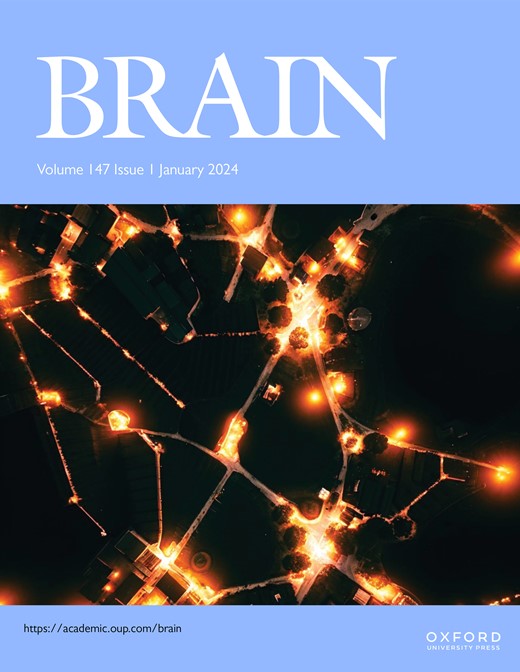Brain health concerns in former rugby players: clinical and cognitive phenotypes
IF 10.6
1区 医学
Q1 CLINICAL NEUROLOGY
引用次数: 0
Abstract
Epidemiological studies have shown that elite rugby players are at greater risk of neurodegenerative disease in later life, with post-mortem studies conducted in ex-players demonstrating the presence of neuropathologies related to repetitive head impacts, such as chronic traumatic encephalopathy. However, detailed prospective data establishing the clinical presentation of former rugby players with brain health concerns are lacking. In particular, the rates of traumatic encephalopathy syndrome, the clinical correlate of chronic traumatic encephalopathy, and the relationship between clinical outcomes and repetitive head impacts are unknown. Two hundred former elite rugby players with brain health concerns and 33 matched healthy control subjects were assessed. Self-reported concussion history, career duration, player position, self-rated scales of depression, anxiety, sleep quality, post-concussion symptoms and quality of life, self and informant ratings of neuropsychiatric symptoms and executive function behaviours, were obtained. Formal cognitive testing, traumatic encephalopathy syndrome classification and 3 T MRI were performed. Former players had a median age of 44 years (90.5% male, median career length = 10.5 years, median self-reported career concussions = 7); 63% were forwards and 37% were backs. Ex-players had elevated scores compared to controls on all symptom scales except sleep quality. Despite frequent subjective memory complaints, performance on cognitive testing did not significantly differ from controls. No players fulfilled criteria for dementia. Twenty-four former players fulfilled research criteria for traumatic encephalopathy syndrome (seven with cognitive impairment, 12 with neurobehavioral dysregulation, five with both). Provisional levels of certainty for chronic traumatic encephalopathy were relatively low (21 ‘suggestive’, three ‘possible’, zero ‘probable/definite’). Forwards and those with higher self-reported concussions were more likely to be classified as having traumatic encephalopathy syndrome based on neurobehavioral disturbance. Symptom burden (depressive and anxiety symptoms, post-concussion symptoms, behaviour rating of executive dysfunction, and neuropsychiatric symptom severity) was higher in those with higher self-reported concussions but was unrelated to years of play or position played. Cavum septum pellucidum was visible on structural imaging in 24% of players (12% in controls) and was more common in the high compared to low concussion group (32% versus 16%). In summary, former elite rugby players in mid-life had significant symptom burden, especially those self-reporting more concussions. In contrast, objective cognitive impairments and traumatic encephalopathy syndrome were relatively uncommon and there was no evidence of dementia. These results provide insights into the clinical presentations of former elite rugby players with brain health concerns during mid-life and highlight the complex relationship between symptoms, cognition and head impact exposure.前橄榄球运动员的大脑健康问题:临床和认知表型
流行病学研究表明,优秀橄榄球运动员在晚年患神经退行性疾病的风险更大,对前球员进行的尸检研究表明,存在与反复头部撞击有关的神经病理学,如慢性创伤性脑病。然而,建立前橄榄球运动员与大脑健康问题的临床表现的详细前瞻性数据是缺乏的。特别是,创伤性脑病综合征的发病率、慢性创伤性脑病的临床相关性以及临床结果与反复头部撞击之间的关系尚不清楚。对200名有大脑健康问题的前橄榄球精英运动员和33名健康对照者进行了评估。获得自我报告的脑震荡病史、职业生涯持续时间、球员位置、抑郁、焦虑、睡眠质量、脑震荡后症状和生活质量自评量表、神经精神症状和执行功能行为的自我和信息提供者评分。进行正式认知测试、创伤性脑病综合征分型及3t MRI检查。前运动员年龄中位数为44岁(90.5%为男性,职业生涯中位数为10.5年,自我报告的职业生涯脑震荡中位数为7次);63%是前锋,37%是后卫。除睡眠质量外,前球员在所有症状量表上的得分都高于对照组。尽管经常出现主观记忆抱怨,但在认知测试中的表现与对照组没有显著差异。没有球员符合痴呆的标准。24名前球员符合创伤性脑病综合征的研究标准(7人有认知障碍,12人有神经行为失调,5人两者兼有)。慢性创伤性脑病的临时确定性水平相对较低(21个“暗示”,3个“可能”,0个“可能/确定”)。前锋和那些自我报告脑震荡率较高的人更有可能被归类为基于神经行为障碍的创伤性脑病综合征。症状负担(抑郁和焦虑症状、脑震荡后症状、执行功能障碍的行为评分和神经精神症状严重程度)在自我报告较高的脑震荡患者中较高,但与打球年数或打球位置无关。在24%的球员(对照组12%)的结构成像上可见透明隔腔,在高震荡组比低震荡组更常见(32%比16%)。综上所述,前精英橄榄球运动员在中年有显著的症状负担,特别是那些自我报告更多的脑震荡。相比之下,客观认知障碍和创伤性脑病综合征相对罕见,没有痴呆的证据。这些结果为前精英橄榄球运动员在中年时期出现大脑健康问题的临床表现提供了见解,并突出了症状、认知和头部撞击暴露之间的复杂关系。
本文章由计算机程序翻译,如有差异,请以英文原文为准。
求助全文
约1分钟内获得全文
求助全文
来源期刊

Brain
医学-临床神经学
CiteScore
20.30
自引率
4.10%
发文量
458
审稿时长
3-6 weeks
期刊介绍:
Brain, a journal focused on clinical neurology and translational neuroscience, has been publishing landmark papers since 1878. The journal aims to expand its scope by including studies that shed light on disease mechanisms and conducting innovative clinical trials for brain disorders. With a wide range of topics covered, the Editorial Board represents the international readership and diverse coverage of the journal. Accepted articles are promptly posted online, typically within a few weeks of acceptance. As of 2022, Brain holds an impressive impact factor of 14.5, according to the Journal Citation Reports.
 求助内容:
求助内容: 应助结果提醒方式:
应助结果提醒方式:


